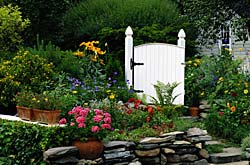Arbor Design: Make a Backyard Shrine
See if We Have Top-Rated
Landscaping Contractors in Your Area

A quick and easy way to enhance the appearance of your landscaping is to add interesting architectural features. Though decking, patios, furniture, grills, and other features are a necessity for any backyard, sometimes installing a few freestanding structures can really help to compliment your preexisting blueprint. Arbor design is hands-down one of the best ways to spotlight a certain section of your yard.
Isn't that the Same As . . .?
You hear the words trellis, pergola, gazebo, and pagoda thrown around a lot and used interchangeably with one another. However, there are small differences between these structures. A gazebo is an actual outdoor building with at least four sides or posts, a full roof, and a wooden or concrete floor (oftentimes a pagoda would be classified as a type of gazebo). A pergola, on the other hand, is simply a leveled style of arbor design: a freestanding assembly that isn't a full shelter so much as two trellises covered with an overarching latticed roof.
So . . . What do they Do?
Beyond adding a bit of architectural flair to your landscaping, these structures can also have a few practical applications as well. Their most common function involves their trellises, in which vines, ivy, roses, or other plant life can weave up between the lattices on either side in order to meet in the middle of the overhead arch. But you could also erect one near a gate to create an ornamental entryway into the backyard. Put one up out in the garden to add flourish to the foliage. Place a planter or a squirrel feeder to one of the sides so you can watch the local wildlife. And though they don't provide the same shelter as a gazebo, most arbor designs come with a slatted roof stretched across its posts to provide a bit of shade over benches or walkways (but, of course, the amount of shadow is determined by the spacing of the overhead lattice). Either way, besides being practical, these installations are easy to set up and always add instant drama to your yard.
Can't decide what to build? Use this link to hire a
Landscape Designer
Types of Arbor Design
Though they have many uses in and of themselves with the proper garden arbor design, these decorative artifacts can become even more valuable. For instance, despite its name these structures don't have to be made solely from wood. Though cedar is a popular material, they're often constructed of wrought iron for a more classic look, PVC for more pragmatic purposes, or even bent tree branches to create a rustic appeal. Plus, they can have different ornamental shapes, especially when it comes to their roofing. The tops can be gabled, peaked, arched, flat (pergola-style), or curved out like a pagoda. But style goes hand-in-hand with location. Attaching one to your house above a deck can create an impromptu gazebo right outside the home. But another good idea is to buy more than one to create a fairytale landscape in your backyard: by placing several back to back, over time you could have a lush runway covered in a flowered canopy leading to your house.
Where do I get Them?
Many garden arbor designs are prefabricated and ready to assemble: it comes with precut wood, tools, and built-in instructions. However, these off-the-shelf products can also be a little flimsy, which isn't very reassuring since they spend their whole lives outside enduring the elements. Also, since they come standardized, they lose some of their distinctiveness. Plus, they can't be positioned anywhere besides the open (they aren't made to be attached to roofs, decking, or preexisting landscaping). So if you want a truly unique garden arbor design, it may be a good idea to go with a professional landscape architect who specializes in these structures. It can cost anywhere from $100 to $1,000 depending on the nature of the job (size, location, and materials), but these experts not only provide blueprints for a customized piece of architecture, they can also assemble them in no time at all using the appropriate equipment and installation techniques.

